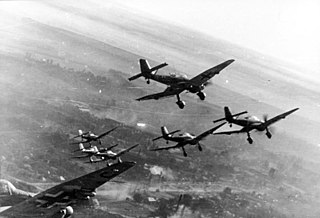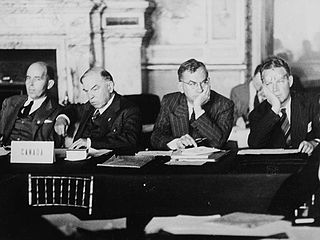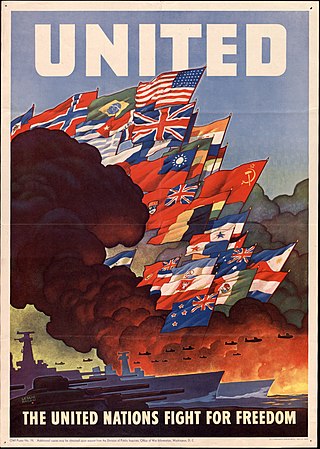Axis leaders met with each other and neutral representatives a number of times during World War II.
Axis leaders met with each other and neutral representatives a number of times during World War II.

World War II or the Second World War was a global conflict that lasted from 1939 to 1945. The vast majority of the world's countries, including all the great powers, fought as part of two opposing military alliances: the Allies and the Axis. Many participating countries invested all available economic, industrial, and scientific capabilities into this total war, blurring the distinction between civilian and military resources. Aircraft played a major role, enabling the strategic bombing of population centres and delivery of the only two nuclear weapons ever used in war. It was by far the deadliest conflict in history, resulting in 70–85 million fatalities. Millions died due to genocides, including the Holocaust, as well as starvation, massacres, and disease. In the wake of Axis defeat, Germany, Austria, and Japan were occupied, and war crime tribunals were conducted against German and Japanese leaders.

The Axis powers, originally called the Rome–Berlin Axis, was a military coalition that initiated World War II and fought against the Allies. Its principal members were Nazi Germany, the Kingdom of Italy, and the Empire of Japan. The Axis were united in their far-right positions and general opposition to the Allies, but otherwise lacked comparable coordination and ideological cohesion.

The Paris Peace Treaties were signed on 10 February 1947 following the end of World War II in 1945. The Paris Peace Conference lasted from 29 July until 15 October 1946. The victorious wartime Allied powers negotiated the details of peace treaties with those former Axis powers, namely Italy, Romania, Hungary, Bulgaria, and Finland, which had switched sides and declared war on Germany during the war. They were allowed to fully resume their responsibilities as sovereign states in international affairs and to qualify for membership in the United Nations. Nevertheless, the Paris Peace Treaties avoided taking into consideration the consequences of the Molotov–Ribbentrop Pact, officially known as the Treaty of Non-Aggression between Germany and the Union of Soviet Socialist Republics, whose secret clauses included the division of Poland between Nazi Germany and the Soviet Union, the occupation of the Baltic States, and the annexation of parts of Finland and Romania. The Molotov–Ribbentrop Pact changed the borders agreed after the Paris Peace Conference (1919–1920), and was signed on August 23, 1939. One week later, World War II started with Nazi Germany's invasion of Poland, followed three weeks later by the Soviet invasion of Poland, which was completely erased from the map. In the following years, Nazi Germany and the Soviet Union changed the borders established by the peace treaties at the end of World War I.
The Kingdom of Romania, under the rule of King Carol II, was initially a neutral country in World War II. However, Fascist political forces, especially the Iron Guard, rose in popularity and power, urging an alliance with Nazi Germany and its allies. As the military fortunes of Romania's two main guarantors of territorial integrity—France and Britain—crumbled in the Fall of France, the government of Romania turned to Germany in hopes of a similar guarantee, unaware that Germany, in the supplementary protocol to the 1939 Molotov–Ribbentrop Pact, had already granted its blessing to Soviet claims on Romanian territory.

The North African campaign of the Second World War took place in North Africa from 10 June 1940 to 13 May 1943. It included campaigns fought in the Libyan and Egyptian deserts and in Morocco and Algeria, as well as Tunisia. The campaign was fought between the Allies and the Axis Powers. The Allied war effort was dominated by the British Commonwealth and exiles from German-occupied Europe. The United States officially entered the war in December 1941 and began direct military assistance in North Africa on 11 May 1942.

The First Quebec Conference, codenamed Quadrant, was a highly secret military conference held during World War II by the governments of the United Kingdom, Canada, and the United States. It took place in Quebec City on August 17–24, 1943, at both the Citadelle and the Château Frontenac. The chief representatives were Winston Churchill and Franklin D. Roosevelt, hosted by the Canadian prime minister William Lyon Mackenzie King.

The Balkans campaign of World War II began with the Italian invasion of Greece on 28 October 1940. In the early months of 1941, Italy's offensive had stalled and a Greek counter-offensive pushed into Albania. Germany sought to aid Italy by deploying troops to Romania and Bulgaria and attacking Greece from the east. Meanwhile, the British landed troops and aircraft to shore up Greek defences. A coup d'état in Yugoslavia on 27 March caused Adolf Hitler to order the conquest of that country.

The Casablanca Conference or Anfa Conference was held in Casablanca, French Morocco, from January 14 to 24, 1943, to plan the Allied European strategy for the next phase of World War II. The main discussions were between US President Franklin Roosevelt and British Prime Minister Winston Churchill. Stalin could not attend. Key decisions included a commitment to demand Axis powers' unconditional surrender; plans for an invasion of Sicily and Italy before the main invasion of France; an intensified strategic bombing campaign against Germany; and approval of a US Navy plan to advance on Japan through the central Pacific and the Philippines. The last item authorized the island-hopping campaign in the Pacific, which shortened the war. Of all the decisions made, the most important was the invasion of Sicily, which Churchill pushed for in part to divert American attention from opening a second front in France in 1943, a move that he feared would result in very high Allied casualties and not be possible until 1944.

The Inter-American Treaty of Reciprocal Assistance is an intergovernmental collective security agreement signed in 1947 in Rio de Janeiro among many countries of the Americas.

The Declaration by United Nations was the main treaty that formalized the Allies of World War II and was signed by 47 national governments between 1942 and 1945. On 1 January 1942, during the Arcadia Conference, the Allied "Big Four"—the United States, the United Kingdom, the Soviet Union, and China—signed a short document which later came to be known as the United Nations Declaration, and the next day the representatives of 22 other nations added their signatures.

The Allies, formally referred to as the United Nations from 1942, were an international military coalition formed during World War II (1939–1945) to oppose the Axis powers. Its principal members by the end of 1941 were the "Big Four" - United Kingdom, United States, Soviet Union, and China.
The U.S.–British Staff Conference was a series of secret discussions between United States and British military staff members on American, British, and Canadian (ABC) military coordination in the event of U.S. entry into World War II. The conference took place in Washington, D.C. from January 29 to March 27, 1941 and concluded with a report entitled "ABC-1" which was tacitly approved by President Franklin D. Roosevelt two days later.

Bulgarian irredentism is a term to identify the territory associated with a historical national state and a modern Bulgarian irredentist nationalist movement in the 19th and 20th centuries, which would include most of Macedonia, Thrace and Moesia.

The Third Moscow Conference between the major Allies of World War II took place during October 18 to November 11, 1943, at the Moscow Kremlin and Spiridonovka Palace. It was composed of major diplomats, ministers and generals, who discussed cooperation in the war effort, and issued the Moscow Declaration.

The Second Cairo Conference of December 4–6, 1943, held in Cairo, Egypt, addressed Turkey's possible contribution to the Allies in World War II. The meeting was attended by President Franklin D. Roosevelt of the United States, Prime Minister Winston Churchill of the United Kingdom, and President İsmet İnönü of the Republic of Turkey.

The neutral powers were countries that remained neutral during World War II. Some of these countries had large colonies abroad or had great economic power. Spain had just been through its civil war, which ended on 1 April 1939 —a war that involved several countries that subsequently participated in World War II.

The Allied oil campaign of World War II pitted the RAF and the USAAF against facilities supplying Nazi Germany with petroleum, oil, and lubrication (POL) products. It formed part of the immense Allied strategic bombing effort during the war. The targets in Germany and in Axis-controlled Europe included refineries, synthetic-fuel factories, storage depots and other POL-infrastructure.

During World War II, a number of significant economic, political, and military changes took place in Latin America. The war caused considerable panic in the region over economics as large portions of economy of the region depended on the European investment capital, which was shut down. Latin America tried to stay neutral at first but the warring countries were endangering their neutrality. In order to better protect the Panama Canal, combat Axis influence, and optimize the production of goods for the war effort, the United States through Lend-Lease and similar programs greatly expanded its interests in Latin America, resulting in large-scale modernization and a major economic boost for the countries that participated.
The Declaration of St James's Palace, or London Declaration, was the first joint statement of goals and principles by the Allied Powers during World War II. The declaration was issued after the first Inter-Allied Conference at St James's Palace in London on 12 June 1941. Representatives of the United Kingdom, the four co-belligerent Commonwealth Dominions, the eight governments in exile and Free France were parties to the declaration. It stated the Allies' commitment to continue the war against the Axis Powers and established principles to serve as the basis of a future peace.